|
Cockpit
Structural Repairs (Page 3)
This page was last updated on
January 30, 2002.
Final
Sanding |
Building
a Lazarette Locker |
Installing
an Access Hatch in the Cockpit
Cockpit
Lockers and Hinges
Cockpit,
Part 1 | Cockpit,
Part 2
|
|
BUILDING
A LAZARETTE LOCKER
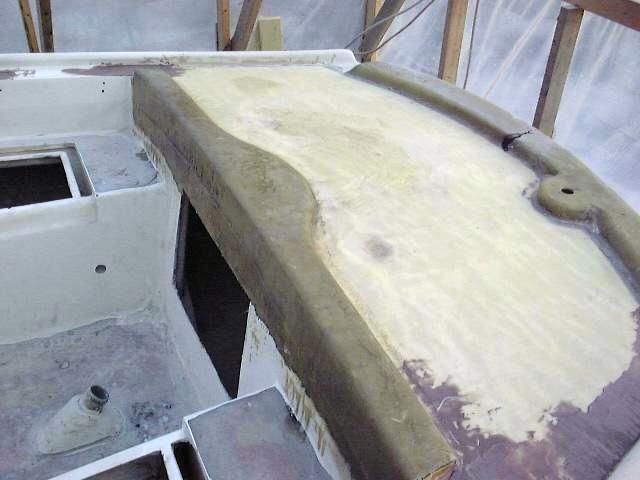 Originally,
I thought of installing a drop-in propane locker in the generally unutilized
space aft of the cockpit. However, upon closer inspection and
consideration, I decided that this might not be the best use for the
space. Plus, there were many complications involved with installing
propane tanks here: the space is severely limited by the angle of the
transom and the backstay chainplate knee, and allowing access to the remainder
of the space, propane locker drain system and engine exhaust would have been
complicated. I will find another solution for the propane tank(s), perhaps
a nice varnished mahogany deck box near the mast or just forward of the cabin
trunk on the foredeck. Originally,
I thought of installing a drop-in propane locker in the generally unutilized
space aft of the cockpit. However, upon closer inspection and
consideration, I decided that this might not be the best use for the
space. Plus, there were many complications involved with installing
propane tanks here: the space is severely limited by the angle of the
transom and the backstay chainplate knee, and allowing access to the remainder
of the space, propane locker drain system and engine exhaust would have been
complicated. I will find another solution for the propane tank(s), perhaps
a nice varnished mahogany deck box near the mast or just forward of the cabin
trunk on the foredeck.
UPDATE: I installed
the LPG tank on deck just forward of the doghouse bump, aft of the mast.
Read about it here.
|
|
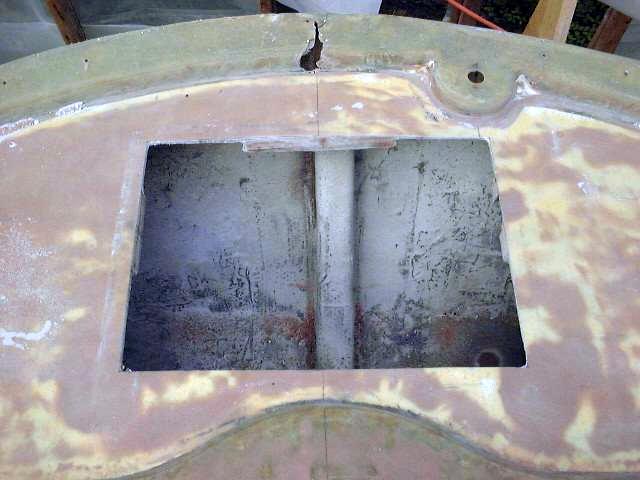 The first step, after determining
the size of the opening necessary, was to cut a large hole in the deck, which
will allow access to the area beneath. I determined a suitable size, and
then cut
the opening with a jig saw. The deck is very thin in this area, with only
some glassed-in plywood supports. I will have to add some reinforcement
beneath around the new opening. The first step, after determining
the size of the opening necessary, was to cut a large hole in the deck, which
will allow access to the area beneath. I determined a suitable size, and
then cut
the opening with a jig saw. The deck is very thin in this area, with only
some glassed-in plywood supports. I will have to add some reinforcement
beneath around the new opening.
|
|
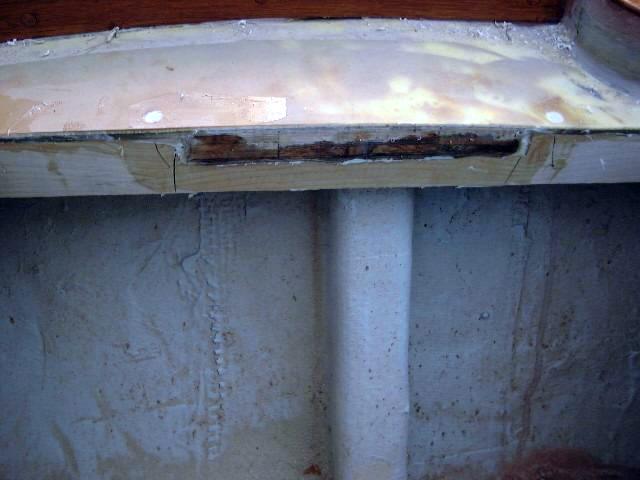 To
reinforce the opening, I epoxied and screwed two hardwood supports athwartships
on either side of the opening. With these glassed in place, the area is
already much stiffer, but I intend to add some vertical supports at the ends to
really help beef up the poop deck. To
reinforce the opening, I epoxied and screwed two hardwood supports athwartships
on either side of the opening. With these glassed in place, the area is
already much stiffer, but I intend to add some vertical supports at the ends to
really help beef up the poop deck.
|
|
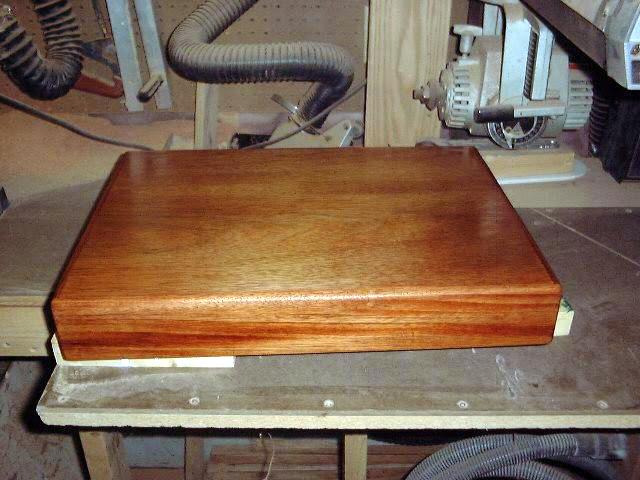 I constructed a mahogany hatch
lid with solid mahogany sides and a 1/2" mahogany plywood top, much the
same way I constructed the sea hood for the companionway. It is a simple
box structure, with the side pieces let into a rabbet on the end pieces to hide
most of the end grain and provide additional strength. The plywood top is
set flush in a rabbet along the top edge. I glued the pieces together with
slightly thickened epoxy, clamped it securely and let it set overnight.
The next morning, I unclamped it and sanded the edges flush with the plywood
top, rounded all the corners, and sanded everything to 220 grit. Then, I
applied the first of 10 coats of varnish. I constructed a mahogany hatch
lid with solid mahogany sides and a 1/2" mahogany plywood top, much the
same way I constructed the sea hood for the companionway. It is a simple
box structure, with the side pieces let into a rabbet on the end pieces to hide
most of the end grain and provide additional strength. The plywood top is
set flush in a rabbet along the top edge. I glued the pieces together with
slightly thickened epoxy, clamped it securely and let it set overnight.
The next morning, I unclamped it and sanded the edges flush with the plywood
top, rounded all the corners, and sanded everything to 220 grit. Then, I
applied the first of 10 coats of varnish.
|
|
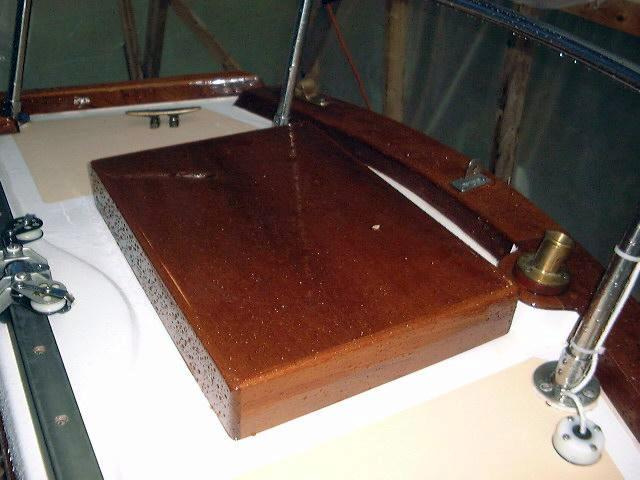 The opening in the deck requires
a lip to help support the lid, and to keep the lazarette more or less
watertight. To that end, I installed a mahogany inner liner of sorts,
epoxying and screwing four pieces to the inside of the opening, leaving about
2-1/4" projecting above deck level. (The inside of the hatch is
2-1/2".) Then, I installed some weather-stripping, and test fit the
hatch. I had to sand the front edge of the inside "liner" in
order for the hatch to slide over it, which made a mess...but the end result was
achieved. The opening in the deck requires
a lip to help support the lid, and to keep the lazarette more or less
watertight. To that end, I installed a mahogany inner liner of sorts,
epoxying and screwing four pieces to the inside of the opening, leaving about
2-1/4" projecting above deck level. (The inside of the hatch is
2-1/2".) Then, I installed some weather-stripping, and test fit the
hatch. I had to sand the front edge of the inside "liner" in
order for the hatch to slide over it, which made a mess...but the end result was
achieved.
Better photos will be on their
way sometime, when I remember!
|
|
COCKPIT
SOLE ACCESS HATCH
The boat originally had a
small round bronze deckplate towards the forward end, which provided limited
access to the stuffing box. It was far too small to be of any real value,
so it was removed early on in the reconstruction process. Accessibility of
all things mechanical is a priority for me, so I spent some energy searching for
the perfect deck hatch. It needed to be large, strong, attractive and,
hopefully, inexpensive.
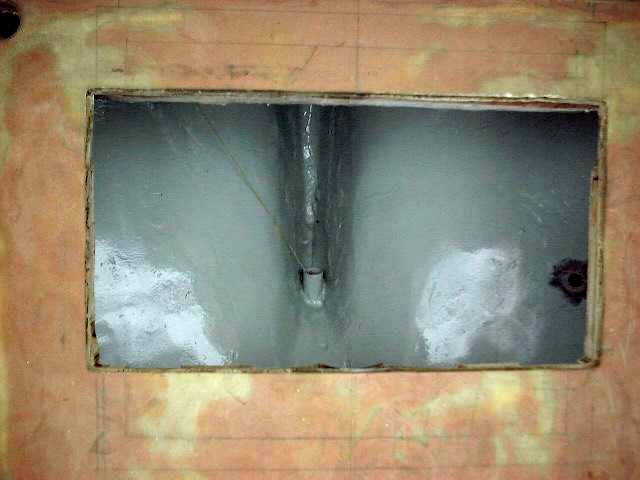 Of
course, you can't have all these things at once! Choose any three. There
are some great aluminum commercial hatches available, but they are prohibitively
expensive and not particularly attractive. Hamilton
Marine had an aluminum Bomar hatch that had potential, with a white-painted
finish, but it was just too expensive at nearly $400. The plastic Bomar
hatches you see everywhere are really flimsy underfoot, although they are
inexpensive. A certain amount of sturdiness is key, since the hatch will
be located in the area of the cockpit where there is a lot of traffic. Of
course, you can't have all these things at once! Choose any three. There
are some great aluminum commercial hatches available, but they are prohibitively
expensive and not particularly attractive. Hamilton
Marine had an aluminum Bomar hatch that had potential, with a white-painted
finish, but it was just too expensive at nearly $400. The plastic Bomar
hatches you see everywhere are really flimsy underfoot, although they are
inexpensive. A certain amount of sturdiness is key, since the hatch will
be located in the area of the cockpit where there is a lot of traffic.
I finally settled on a
Tempress 13" x 23" plastic hatch from West Marine. The price was
fair, at around $80, and the hatch is much sturdier than the similar Bomar
hatches. It's supposed to be reinforced and is intended to be used in
heavy traffic areas, unlike the Bomar, which is really a bulkhead or storage
hatch not meant to be trod upon with any regularity.
|
|
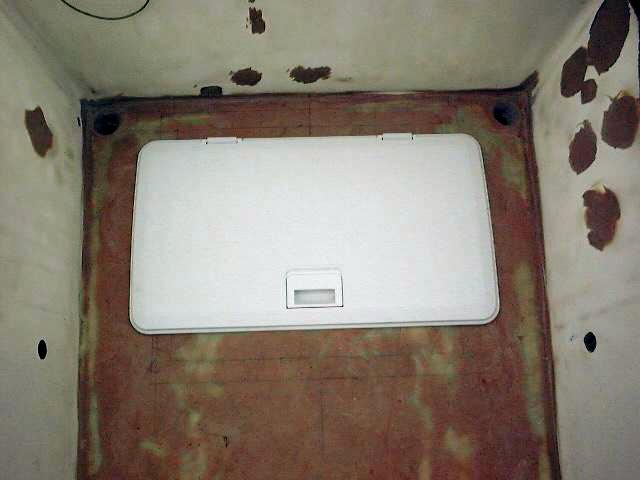 The
hatch came with a template in order to cut out the hole, which made it pretty
easy. The effort was complicated only by the fact that some new blades I
had bought for my saw were the wrong type, and incompatible with my saw. I
used the blades I had on hand, which either broke easily (small, thin scrolling
blades) or cut slowly and created a lot of heat (some down-cutting blades
designed for cutting Melamine or similar laminate products). I went
through about 6 or 7 blades (yikes!), which was all I had, but finally got the
hole cut out. I was cutting through two layers of fiberglass, a balsa
core, and the glassed-in plywood stiffeners beneath. The
hatch came with a template in order to cut out the hole, which made it pretty
easy. The effort was complicated only by the fact that some new blades I
had bought for my saw were the wrong type, and incompatible with my saw. I
used the blades I had on hand, which either broke easily (small, thin scrolling
blades) or cut slowly and created a lot of heat (some down-cutting blades
designed for cutting Melamine or similar laminate products). I went
through about 6 or 7 blades (yikes!), which was all I had, but finally got the
hole cut out. I was cutting through two layers of fiberglass, a balsa
core, and the glassed-in plywood stiffeners beneath.
With the hole cut, I removed
the core from the immediate area, scraping back about 1/2". After
cleaning, I filled this gap with thickened epoxy. The hatch is installed
temporarily at this point; I won't be doing any more permanent installation on
the hatch until the deck painting is complete, so that I won't have to paint
around it. When the time comes, the hatch will be installed with stainless
bolts and silicone caulk. In the meantime, it will give me better access
and light to the rear of the engine room, stuffing box, and fuel tank while I
work on those areas.
|
|
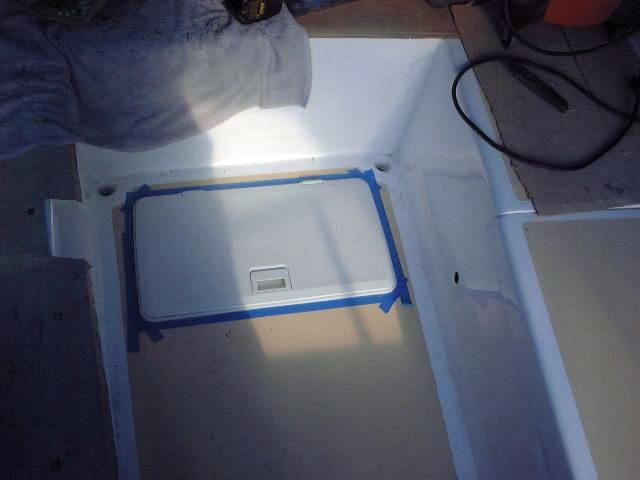 I
installed the hatch permanently with screws and silicone sealant. There
are 12 screws around the edge (hidden by the lid) which are driven into the
solid epoxy that surrounds the hatch opening. With plastic hatches like
this, using polysulfide will actually react with and damage the plastic, so only
silicone may be used. I laid on a heavy bead of silicone and screwed the
hatch down, after taking the time to install masking tape around the perimeter
to protect the deck from excess silicone. When the silicone cured, I ran a
utility knife around to release the excess bead and peeled it and the tape off. I
installed the hatch permanently with screws and silicone sealant. There
are 12 screws around the edge (hidden by the lid) which are driven into the
solid epoxy that surrounds the hatch opening. With plastic hatches like
this, using polysulfide will actually react with and damage the plastic, so only
silicone may be used. I laid on a heavy bead of silicone and screwed the
hatch down, after taking the time to install masking tape around the perimeter
to protect the deck from excess silicone. When the silicone cured, I ran a
utility knife around to release the excess bead and peeled it and the tape off.
UPDATE:
The
hatch leaks somewhat, as the slight crown to the cockpit sole prevents the cover
from fitting securely into the gasket and channel. For the cruising we're
doing now, this is only an annoyance, but should se decide to head more
offshore, I will either reinstall this hatch, or, more likely, replace it with a
really nice, strong aluminum one.
|
|
COCKPIT
LOCKERS AND HINGES
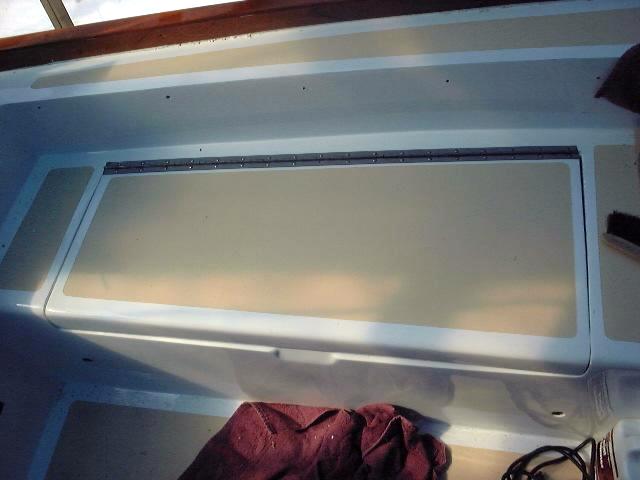 I
installed the original cockpit locker hatches with the original full-length
piano hinges. I used silicone caulk and stainless steel screws.
Later, I'll install some latching
hardware. I
installed the original cockpit locker hatches with the original full-length
piano hinges. I used silicone caulk and stainless steel screws.
Later, I'll install some latching
hardware.
|
|